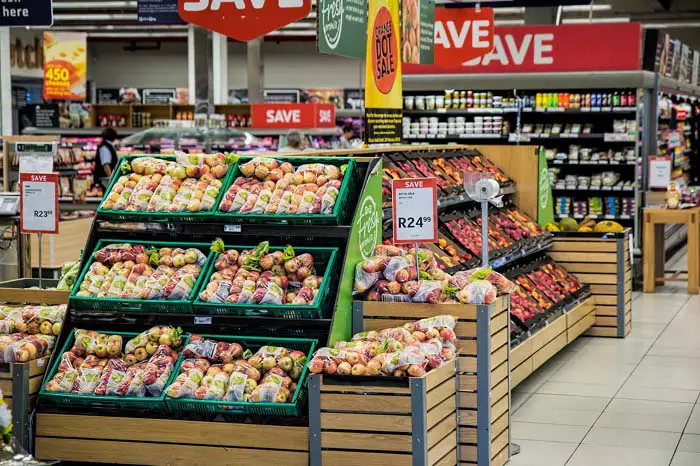Have you had enough of your high grocery bills? If you consistently spend more money on groceries than you would like, there are a number of steps you can take to cut your costs. Just don’t be caught off guard. You may not realize it just yet, but a few minor adjustments can have significant impact on your food spending.
Buying food represents a sizable chunk of most families’ monthly spending plans. You can stop going to restaurants, shopping for new clothes, and adjusting your lifestyle to save money, but food is a necessity for keeping your home running. On the other hand, there are usually a few extraneous items on the weekly or monthly shopping list that you can do without. In that case, how do you place the items? Is there anything else you can do to reduce the grocery bill?
Here’s how you can save with your grocery shopping
Start in the pantry
The cost of groceries can quickly get out of hand if you’re wasteful with your food. There are several ways in which food can go to waste, such as when leftovers get moldy and sticky at the back of the fridge or when fresh vegetables and fruits rot because you forgot them in the crisper drawer. If you leave open boxes of crackers and cereals or fail to zip up freezer bags, you risk wasting food.
To reduce food waste, you should start grocery shopping in the kitchen. You should list what you have on hand and what should be consumed quickly. Remember to take stock of what you have in your fridge and pantry. You can do this by making a list on a spreadsheet or by handing it to yourself.
Plan your meals
You may reduce your next grocery trip’s cost and better use your current food by preparing your meals in advance. However, there is a proper and improper manner of organizing one’s meals. The best approach to meal planning is to keep things realistic.
Rather than looking up recipes online or sifting through cookbooks, stick to simple ones that don’t require a ton of time, money, or ingredients. Find recipes that use common pantry items rather than exotic ones.
Schedule your weekly meals so that similar ingredients appear in multiple dishes.
Cutting meat from a handful of your weekly meals is a great way to save money. Nuts, tofu, and beans, which are all good vegetarian protein sources, are much less expensive than meat.
Not only should you prepare for the typical three meals a day, but also for snacks in between. Leave room in your meal plan for takeout or eating out if you know you’ll order it frequently.
Since leftovers are often unavoidable, plan for them as well. One night’s dinner can be ideal as the basis for the next day’s lunch. You could also prepare a meatloaf sandwich with the leftovers from the night before.
When you go to the store, stock up on food for at least a week at a time

Going grocery shopping for only a couple of days at a time is the worst drain on your wallet. Spending too much time at the grocery store leads to impulse purchases, wasted money, a disorganized fridge, and wasted food. This is the last thing we need when trying to reduce food costs.
If you only go to the grocery store once a week or once every other week, you’ll save time and money. It will also motivate you to stop winging it when it comes to preparing food and instead develop a system that works for you. You will need to master the art of meal planning to ensure you never waste time or money by making unnecessary trips to the supermarket.
Carry a bag while out shopping
You can save money by bringing your reusable bags to the store. When you shop at certain grocery stores, you may receive a discount if you bring in your own reusable bags. Take the supermarket, for example; they might knock a few cents off your total for every reusable bag you bring.
Even if this isn’t possible in all shops, using less plastic is still a good idea. More importantly, reusable bags are much less likely to break than single-use ones.
Do your grocery shopping online
You can save a lot of money by doing your weekly food shopping online, where you won’t be tempted by the store’s aromas or other products.
You don’t have to hurry when you shop online, so you can take some time to consider whether you really need the things you’ve put in your cart.
The shipping costs could be high, but if you’re willing to try a new service, you can get discounts or even free shipping as part of a promotion.
How often do you spend far more than the delivery fee in a store because you give in to impulse buys?
Picking up your online purchases in-store could save you money on shipping fees. Simply put, after you place your online order, you set up a time to pick it up at your local grocery store.
Picking up an item is usually 50 to 75 percent less expensive than having it delivered, and you can purchase it online if that option is available. Buying groceries online can help you save money.
Look out for expiration dates
Though it’s a pain to do, it’s important to keep an eye on those expiration dates. No one wants to purchase milk that will spoil the day after they get it, and the same goes for a lot of other goods. Shop for items with the longest expiration dates. This might give you time to get the most use out of whatever you’re purchasing.
Dates of expiration can be useful tools as well. Some retailers offer exceptional bargains on near-expired bakery items. Look at the bread section. Prices could be lowered, and you could obtain your favorite bread for a lower-than-usual cost. Get some and put it in the freezer, or use it immediately!
Prioritizing your requirements
Identifying what you truly require versus what you’d like to have can be applied to more than simply material purchases. You can use this strategy while you are building your grocery budget too. It’s easy to go out and purchase a bunch of odd foods that sound good, even if you do not need them.
For example, is steak essential every week for dinner, or might you substitute something cheaper? You may save a lot of money each month if you learn to shop smart and only buy the things you really need.
Purchase into a community farming group
A community-supported agriculture share can help you save money on food if you are willing to try new things, cook meals at home often, and eat a lot of vegetables.
Buying a “share” guarantees a weekly delivery of a set amount of products from a farmer or group of farmers in exchange for a lump sum or periodic payments. Though most programs are available from late spring to late fall, some are available year-round.
Paying for one of these programs can decrease grocery expenses in the long run, but a hefty initial investment is required. With a share, you can avoid spending money on gas and food shopping to save money.
Using cash
Consumers are more likely to make impulsive purchases when using a debit or credit card. Having cash on hand can make staying within your monthly food budget easier. The cash envelope budgeting method could be helpful for people who want to switch from plastic to cash.
In these bill-paying envelopes, you can save cash in predetermined amounts. For the month’s groceries, you may dedicate one entire envelope. Maintaining your financial plan with this method in place is helpful.
Use a store rewards card
Reward cards, points, or free discounts are available at several supermarkets. You can use these cards in stores to gain discounts, rewards, and other perks.
If you don’t have a shop card, you probably won’t be able to buy what you want during the sale. However, it’s simple to forget about the promotions and miss out on the savings.
Keep your points card next to your payment method to ensure you always get your savings. Be sure to visit customer service in order to adjust the price if you were not asked for your coupon or did not remember to use it.
Don’t forget that you can use the points card online as well. Using a rewards card helps ensure you don’t overspend on food each month.
Change your favorite grocery shop
Despite selling essentially the same items, not all supermarkets set their prices the same. It is common knowledge that certain stores charge significantly more than their competitors. It’s a matter of pride for several chains that offer reasonable costs.
Don’t assume the products sold in a discount supermarket are lower quality than those sold at more expensive establishments. Stores catering to a tighter budget are able to provide their products at reduced prices. This is because they operate with fewer overhead expenses.
Figure out where to put your food supplies
Your fridge will become your closest ally. Shelf life isn’t usually an issue with instant noodles, seasoning mixes, and canned products, but that’s not the case for everything.
Fresh produce, such as fruits and vegetables, only lasts a week or two in the refrigerator before they need to be replaced.
But you can extend their shelf life by keeping perishables in the ideal spots in the freezer and refrigerator.
After returning from the grocery store, you should promptly place all the meat in the freezer. When meat is on sale, don’t hesitate to stock up and freeze it so you can enjoy it for weeks. Bread can be treated in the same way.
Purchase in bulk
Considering bulk food purchases is a good first step if you’re looking for ways to cut costs at the grocery store. Except for perishable items like fresh produce, it is typically more cost-effective to purchase food in bulk and store it until you need it.
If you want to purchase in quantity, you can save money in grocery stores and supermarkets. For instance, pasta is a staple every household needs, so it makes financial sense to buy it in quantity if possible.
Create a grocery list
The average amount we spend on food each week is more than we should. There are times when we shop for more than we need, and other times when we forget entirely what we came in to get.
Like a to-do list, grocery shopping helps us remember what to buy and stick to our spending limits. Although seemingly obvious, you should not disregard this factor. When you run out of something specific, how often do you leave the store with stuff you did not really require?
If you want to avoid overspending on groceries while sticking to a strict budget, make a list before you go (either on paper or on your phone if that feels more modern).
Conclusion
If you’re only going to try one thing, pick a great piece of advice to attempt. In fact, if you want to save the most while grocery shopping on a tight budget, the best thing you can do is to plan your snacks and food items. Making a list of what you should purchase, what you already have, and what’s on sale is much easier if you take the time to plan.
Making a healthy, inexpensive meal plan is possible without effort. Your meal planning should begin with 2 or 3 dinners, an easy-to-prepare breakfast, snacks, and leftovers for work lunches. Before deciding to dislike something new, you should test it for yourself. You and your financial plan could appreciate the money and time you save.

